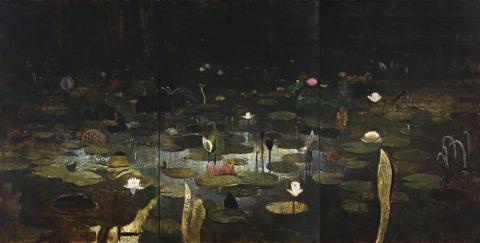NIGHT POOL, 2006
LAWRENCE DAWS
oil on three canvas panels
183.0 x 361.0 cm (overall)
signed lower left: DAWS
Philip Bacon Galleries, Brisbane, acquired 2002
The K.D.H. Ainsworth Collection, Queensland
When Daws first embarked upon the lyrical theme of the lily pond during the mid-1970s, it was in stark contrast to the dark pessimism that had hitherto so distinguished his oeuvre with its complex, disquieting images of portent, conflict and potential catastrophe. Seemingly bereft of any overt menace, such works offered a refreshing antidote to the turbulent, allegorical sequence immediately preceding (exemplified by lot 22) and a fitting prelude to his subsequent meditations upon the majestic, primeval landscape of his home in 'Owl Creek', near the Glasshouse Mountains in Queensland. Inspired specifically by the artist's first-hand experience of the rainforest within the Eungella Ranges inland from Mackay, his tranquil depictions of this lush arcadian idyll betray stylistic affinities not only with Monet's celebrated motif, but with the art of his friend and fellow painter, Ian Fairweather and especially, his interest in Taoism and Chinese art. Illuminating Daws's pond compositions, indeed Neville Weston suggests:
'It is not conceived as a form of homage to the late Monet, but one cannot look at any lily pool without some thought of Giverny. Indeed it is Monet who has made us see such images. Monet's work was always about the act of perception, and the resultant act of painting. Daws, too, relates to the experience of seeing, but usually filtered through the ameliorating passing of time. Daws would have seen lily ponds on Bribie Island and although in so many ways his work lacks any obvious reference to Fairweather's work, that Taoist concern for the gentle bend with the wind, the middle way, and the calligraphic all-over quality of Fairweather's best work do come to mind when I look at the little pool paintings.1
As frequently witnessed amidst his late production, in Night Pool, 2006 Daws revisits that rainforest first encountered over half a century ago to create a composition that is as much a memory of the landscape as an actual depiction. A beautiful work exuding lyricism and tranquility, it symbolises perhaps the culmination of the artist's own inner pilgrimage; as Daws mused in 1996, '[There] are still a few things I need to unravel. ... I'd like to get to a certain stillness, a balance in all directions. I'd like to paint less but get more into each one " that sense of della Francesca's divinely inspired world. Actually, I wouldn't mind coming out into the sun, not having stuff coming up from the dark inners demanding attention.'2 Significantly, a decade later when he executed the present work, Daws felt 'he had reached a calm plateau',3 feeling 'a certain serenity at last.'4 With its mysterious spiritual quality and enigmatic stillness reminiscent of his Quattrocento mentor, indeed Night Pool may be considered the visual embodiment of that sacred place.
1. Weston, N., Lawrence Daws, Reed, Sydney, 1982, p. 125
2. Daws, cited in Waldren, M., 'The Daws of Perception', The Australian Magazine, 3-4 August 1996, p. 29
3. Brown, P., 'Soul searching', Brisbane News, 21-27 August 2002, p. 31
4. Daws, cited in Smith, S., 'Artist pays homage to forces of cosmos', The Courier-Mail, Brisbane, 19 August 1993
VERONICA ANGELATOS
